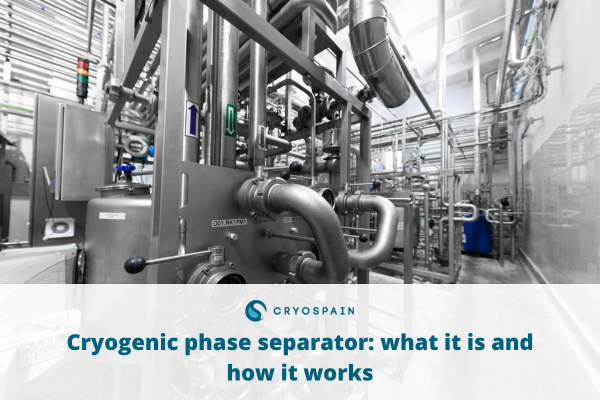The cryogenic phase separator stands out as yet another key component within cryogenic equipment. As cryogenic applications hold an increasing importance in a multitude of fields today, components such as this remain crucial for accessing all benefits of cryogenic engineering, from the rise of liquid nitrogen to Liquid Natural Gas.
Let’s take a look at the main aspects of the cryogenic phase separator including how it works and its applications.
What is a cryogenic phase separator?
A cryogenic phase separator is a piece of equipment that adjusts a system’s working pressure and thus enhances the quality of liquid gasses. As such, it is a crucial element to ensure the proper functioning of a number of cryogenic applications.
As cryogenic fluids typically exist as a mixture in different phases, the cryogenic phase separator acts to enable their separation, so that components can be extracted and a purer cryogenic fluid can be achieved.
All in all, this piece of equipment guarantees the temperature and pressure conditions within the storage vessel match those that are needed at the production process. In order to do so, As supply valves are opened, the liquid is typically de-pressurised, generating a big amount of cold vapor. The cryogenic phase separator performs a split into liquid and vapor streams, so that a controlled elimination of this vapor from the pressurized liquid is achieved. The result is high-quality liquid, with the vapor stream vented to the atmosphere.
Keep reading: Cryogenic liquids: what they are, how they are obtained and what they are used for
How does a cryogenic phase separator work?
An internal storage dewar within the cryogenic phase separator manages to bring liquid gas to a standstill, which makes gas bubbles naturally rise. Through the opening of a relief valve at the top of the dewar, the gas is released, so that the liquid gas remains at the bottom.
In the case of a phase separator for liquid nitrogen, the liquid nitrogen (which presents a higher pressure) flows into the vessel and is subjected to a sudden change of volume that translates into a phase separation. Again, the gas is vented out to the atmosphere, keeping the liquid nitrogen within the vessel and at the desired pressure values.
Applications and uses of a cryogenic phase separator
The aim of the cryogenic phase separator is to ensure pure liquid gasses (high quality and free from bubbles) can be accessed.
This is important for the industries making use of applied cryogenic technologies, including the medical, food, automotive and electronics industries.
As such, the cryogenic phase separator is playing a key role in the production of Liquefied Natural Gas (LNG), as they’re able to separate impurities from natural gas to produce high-purity LNG. It’s also crucial in cryogenic distillation processes, as well as cryogenic and storage transportation systems.
Specifications of a cryogenic phase separator
The specifications of a cryogenic phase separator can vary depending on the specific application and requirements it’s intended to fulfill. However, when considering a cryogenic phase separator, there are some general specifications that are typically considered:
- The phase separator’s temperature range, which can typically go from -150°C (-238°F) to -270°C (-454°F) or even lower, depending on the application.
- Pressure ranges, going from a few bar (tens of psi) to several hundred bar (thousands of psi).
- Its capacity, as they come in different sizes and capacities to handle various flow rates (from a few hundred kilograms per hour to several hundred tons per hour)
- Insulation system options include vacuum insulation and multilayer insulation (MLI), among others
- The separation mechanism
- Control systems to monitor and regulate the separation process. Included here are temperature and pressure sensors, level indicators, flow meters, and control valves.
Keep reading: Cryoline: the ideal pipe system for the transportation of cryogenic liquids
Why is it important in the cryogenic process?
As we’ve seen above, the cryogenic phase separator represents an essential component that enables the separation, purification, and recovery of components from cryogenic fluids.
As such, it plays a key role in the purification of cryogenic fluids, and is also instrumental in achieving efficient cryogenic distillation.
Their role is thus to not only perform these operations, but to do so ensuring efficiency and safety throughout the variety of industrial processes that rely on low-temperature operations and cryogenic engineering.
It’s also worth noting that the cryogenic phase separator plays a part in enhancing sustainability within cryogenic engineering. This is because, through its separation and recovery processes, it helps minimize waste and optimize the use of resources.
Cryospain, cryogenic engineering experts
At Cryospain, we deliver cryogenic engineering adapted to the needs of each project. Throughout our decades-long experience in cryogenic projects, we’ve become experts in guaranteeing the highest quality in the supply of equipment, all while provided the needed technical support and maintenance.
As such, we’re able to deliver the cryogenic phase separator that adapts to each project’s needs, taking care of any potential design, manufacture and commission needs of cryogenic installations.
Get in touch with our team and discover how we can help you with your cryogenic project.










 Contacte-nos
Contacte-nos